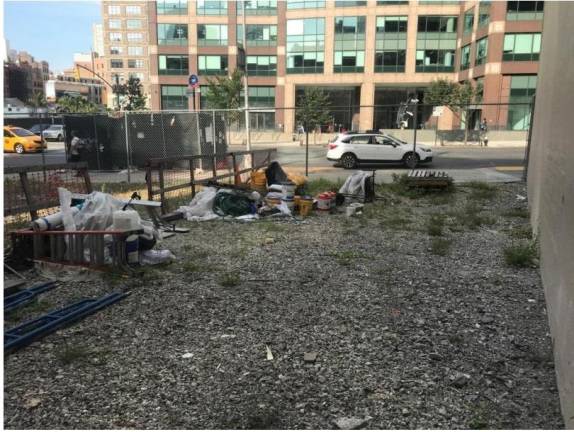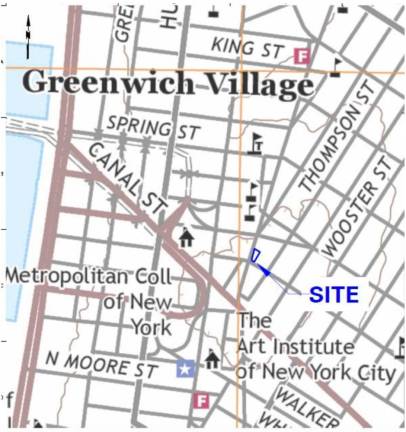Trinity Church Wanted To Build 6-Story Office Building In SoHo, Stuck With Brownfield Polluted By Old Gas Station Instead
The famed Episcopalian church bought a commercially zoned site at 92-98 Avenue of the Americas in SoHo, and told the Department of Environmental Conservation that they wanted to develop a six-story office building on it. First, however, they’d have to reckon with the site being a toxic brownfield–and finish a cleanup process that has been taking years. Has the collapsing commercial real estate market frustrated the outlook for Trinity’s plans?
On its website, Trinity Church Wall St. is proud to recount the history of its charter, granted by King William III in 1697. The rent was, well, low–only one peppercorn payable to the crown annually, in fact.
Yet with the passage of centuries, not to mention the rise of secularized and speculative markets, the financial machinations required of Trinity have naturally become more thorny. The latest hurdle is a six-story office building in SoHo held up by a thorough environmental review, namely due to the construction site in question remaining a seriously polluted brownfield.
According to an Environmental Site Remediation database provided by the Department of Environmental Conservation (DEC), the property at 92-98 Avenue of the Americas–a 4,328 square ft. lot–has been developed since 1894. With its bedrock constituting part of the hardy Manhattan Schist Formation, decades of human intervention have added brick, glass, coal, and metal ash to the mix.
The site hosted a chemical manufacturing facility in 1922, a confectionary and malts product company by 1927, and a gas station from 1950 to 2005 (its most recent use). Resultantly, the site was home to a 550-gallon waste oil container as well as underground storage tanks (USTs) filled with gasoline, which were only removed by 2003 at the latest. It’s no surprise, therefore, that the DEC has found semi-volatile organic compounds exceeding the maximum permissible amount in the site’s soil. Even more notably, volatile organic compounds including xylene (which can lead to severe symptoms including death in cases of high exposure) were found concentrated in the site’s groundwater–at concentrations that exceeded the maximum allowable amount hundreds of times over. This is what Trinity would have to address in a chemical cleanup before the property could be developed.
Trinity got the ball rolling in an August 29, 2019 “Brownfield Cleanup Agreement” with the DEC. Matthew Fox, the director of Asset Management for Trinity, signed on behalf of the church. By June 30th, 2020, they had commissioned a required “remedial investigation work plan” from Langan, an architecture and engineering company located on W. 31st St. that also doubled as the church’s designated “environmental consultant.” This outlined everything from reporting requirements on community air pollution (to be gathered over the course of the cleanup) to the rules for installing groundwater monitoring wells.
The work plan, which was a draft, was paired with a public comment period whereby local residents with concerns could contact DEC project managers personally. No serious drama was evident, but a long lapse in the project nevertheless ensued.
On April 23rd of this year, another key piece of the puzzle for Trinity was finally completed: a “remedial investigation report” by Langan, which was the nearly 22,000-page result of the remedial investigation work outlined in 2020. It concluded, among other things, that “petroleum-related contamination was identified in soil and groundwater across the site”–a clear reference to the latent effects of the underground storage tanks used by the vacated gas station.
Rodney Rivera, a special assistant at the DEC that is partially responsible for the cleanup, told Our Town Downtown that the April remedial investigation project is still being reviewed by the department. If it is approved, Trinity will have to submit a Remedial Action Work Plan or RAWP, and according to Rivera “this RAWP will detail the cleanup standards and describe how the contamination will be addressed. The RAWP will also include a proposed schedule for the cleanup process and building construction.” A 45-day public comment period will also be initiated by the RAWP.
As for now, Trinity’s real estate plans remain stuck in a bureaucratic thicket. Reached for comment, Matthew Fox–who signed the original cleanup agreement in 2019–flat-out denied that Trinity had any plans for 92-98 Avenue of the Americas whatsoever, or for that matter had any schedule in place for the cleanup. This latter claim is technically true as of now, although it doesn’t explain why the original office building development plan wasn’t acknowledged.
Indeed, given the moribund prognosis for commercial real estate in downtown Manhattan these days, perhaps Trinity is reconsidering its asset portfolio. With an onerous clean-up process that is taking years to finalize, it may be that Trinity has quietly scrapped the original redevelopment plan.
A more likely scenario (given the DEC confirming that April’s remedial report is still being actively reviewed, which would indicate that the project is still underway) is that Trinity is keeping the project on the hush-hush before the latest public comment period begins, which will inevitably stir up controversy about possible contaminants being stirred up in the SoHo neighborhood.
As for now, an Environmental Remediation Project map provided by the state indicates that the cleanup may not be done until the end of 2024, meaning Trinity is ostensibly stuck with an old gas station lot that makes for a hard sell and a harder fix.

